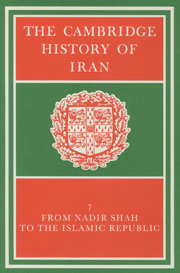Book contents
- Frontmatter
- PART 1 THE POLITICAL FRAMEWORK, 1722–1979
- PART 2 FOREIGN RELATIONS
- PART 3 ECONOMIC AND SOCIAL DEVELOPMENTS
- 13 LAND TENURE AND REVENUE ADMINISTRATION IN THE NINETEENTH CENTURY
- 14 THE TRIBES IN EIGHTEENTH- AND NINETEENTH-CENTURY IRAN
- 15 THE TRADITIONAL IRANIAN CITY IN THE QāJāR PERIOD
- 16 EUROPEAN ECONOMIC PENETRATION, 1872–1921
- 17 ECONOMIC EVELOPMENT, 1921–1979
- 18 THE IRANIAN OIL INDUSTRY
- PART 4 RELIGIOUS AND CULTURAL LIFE, 1721–1979
- Genealogical tables
- Bibliographies
- Index
- References
17 - ECONOMIC EVELOPMENT, 1921–1979
from PART 3 - ECONOMIC AND SOCIAL DEVELOPMENTS
Published online by Cambridge University Press: 28 March 2008
- Frontmatter
- PART 1 THE POLITICAL FRAMEWORK, 1722–1979
- PART 2 FOREIGN RELATIONS
- PART 3 ECONOMIC AND SOCIAL DEVELOPMENTS
- 13 LAND TENURE AND REVENUE ADMINISTRATION IN THE NINETEENTH CENTURY
- 14 THE TRIBES IN EIGHTEENTH- AND NINETEENTH-CENTURY IRAN
- 15 THE TRADITIONAL IRANIAN CITY IN THE QāJāR PERIOD
- 16 EUROPEAN ECONOMIC PENETRATION, 1872–1921
- 17 ECONOMIC EVELOPMENT, 1921–1979
- 18 THE IRANIAN OIL INDUSTRY
- PART 4 RELIGIOUS AND CULTURAL LIFE, 1721–1979
- Genealogical tables
- Bibliographies
- Index
- References
Summary
THE IRANIAN ECONOMY IN THE EARLY YEARS OF THE CENTURY
Economic conditions in Iran before 1912, when commercial oil exports were first made, were perceived by foreign travellers to be deteriorating. Curzon's sweeping conclusions on the state of manufacturing industry in Iran, that “factories, as the term is understood in Europe, do not exist in Persia; and the multiplication and economy of labour-force, by the employment of steam-power, or even water-power, is hardly known” and that “there was a decadence of native ingenuity, consequent upon the importation of cheap European substitutes,” were found to hold true in the early years of the twentieth century. Issawi noted that “Iran … was relatively little affected by the [economic] changes taking place in the world until the exploitation of oil.” Even as late as 1934, European assessment of the Iranian economy stressed the lack of discernible development of a modern economy, while there is evidence that the oil industry operated as an economic enclave with few linkages created into other domestic activities. Agriculture, too, while not lacking entirely its own dynamic of change arising from natural events such as occurrence of good and bad crop years, or political interventions for reasons of taxation and competition for land ownership, was for the most part unaffected by systematic improvements in production and yields. Not until 1937 was there an attempt to provide a new basis for modernization, a move that came to nothing as a result of Rizā Shāh's lack of conviction in the need for agricultural change and, later, the difficult position of the government after his abdication in 1941.
- Type
- Chapter
- Information
- The Cambridge History of Iran , pp. 608 - 638Publisher: Cambridge University PressPrint publication year: 1991



